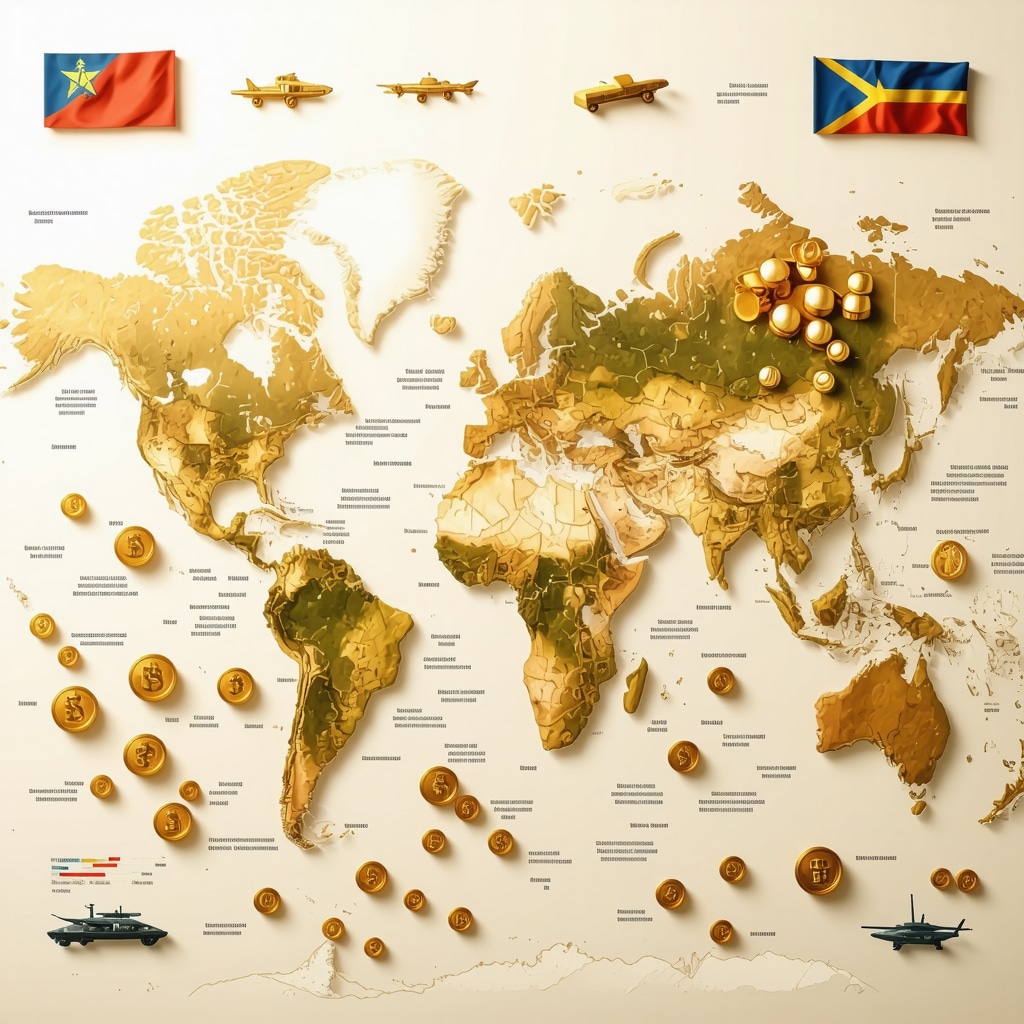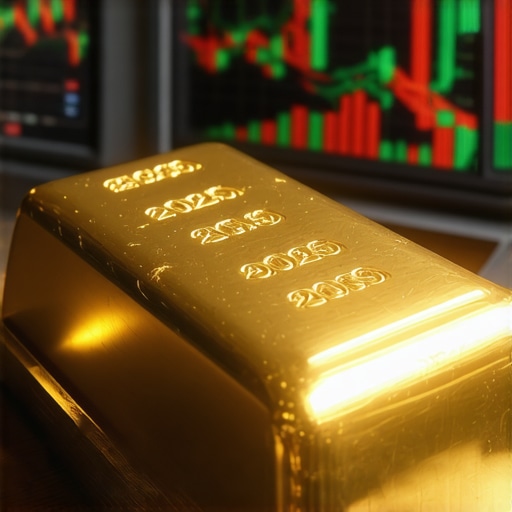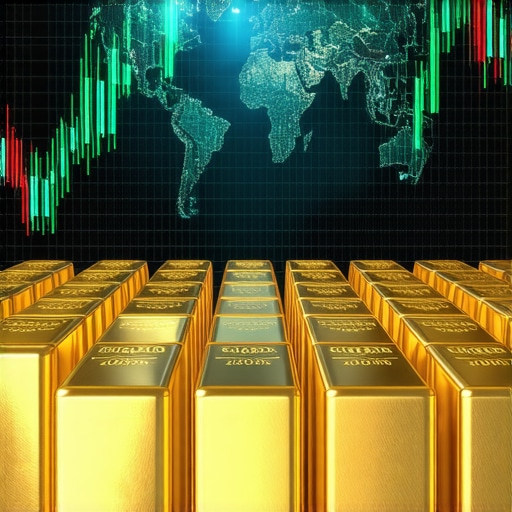Glitter and Guns: Why Gold Prices Dance to the Tune of Geopolitics
Picture this: a tense summit in a far-off land, unexpected sanctions, or a sudden military skirmish — and suddenly, gold prices spike like they’re trying to dodge flying bullets. It’s no secret to seasoned investors that gold isn’t just a shiny metal; it’s a global barometer of geopolitical stress. From the Cold War to modern-day conflicts, gold has been the go-to refuge when the world’s political climate turns stormy.
When Headlines Hit Hard: The Real Impact on Gold Prices
Every tweet from a world leader or every uneasy ceasefire announcement can send ripples through the gold market. Investors flock to gold as a safe haven, pushing prices higher amid uncertainty. But it’s not just about conflict—trade wars, diplomatic tensions, and even sanctions play their part. The complexity is fascinating; gold’s price often reflects not just immediate fears but long-term geopolitical calculations.
Is Gold the World’s Ultimate Political Insurance Policy?
Ask any market watcher, and they’ll tell you gold acts like an insurance policy against the unexpected. But can it truly hedge against every geopolitical curveball? While gold’s stability shines during crises, savvy investors know to watch economic indicators and central bank moves closely. For those looking to dive deeper into strategic gold investing, exploring mastering gold market analysis can provide an edge.
The Subtle Art of Reading Gold’s Political Pulse
Understanding how geopolitics influence gold prices isn’t just about reacting to headlines; it’s about anticipating the market’s mood swings. Factors like central bank gold purchases, sanctions on gold-producing countries, and shifts in global alliances can all subtly nudge prices. For instance, the Investopedia analysis highlights how gold’s role as a safe haven intensifies during geopolitical turmoil, driving demand upward.
If you have stories or thoughts about how recent geopolitical events have affected your gold investments, feel free to share in the comments below. Your insights enrich this ongoing conversation about gold’s unyielding allure in uncertain times.
Gold’s Role Amid Global Sanctions and Economic Shifts
Sanctions have become a potent geopolitical instrument, often targeting key nations’ economies to influence political outcomes. These measures can dramatically affect gold’s global supply chains and market accessibility. For example, sanctions on gold-producing countries can restrict official exports, tightening supply and often elevating prices. Investors need to consider how these sanctions indirectly amplify gold’s appeal as a safe haven asset and disrupt conventional trading flows.
Moreover, economic shifts driven by geopolitical events — such as currency devaluations or trade embargoes — frequently push investors toward gold, reinforcing its role beyond just a commodity. This dynamic interplay between policy and market reactions is pivotal for anyone aiming to understand or anticipate gold price movements.
Central Banks: The Silent Geopolitical Players in Gold Markets
Central banks around the world act as significant influencers in gold’s geopolitical narrative. Their strategic gold purchases or sales are often closely tied to political considerations, such as safeguarding national reserves against currency volatility or signaling economic independence. For instance, recent data shows that countries like China and Russia have ramped up gold acquisition in response to global political tensions, thereby impacting global supply and pricing.
These moves underscore the importance of monitoring central bank activities as a key component in evaluating gold’s political sensitivity. For a more detailed breakdown on how central bank gold purchases shape the market, readers can explore comprehensive insights at Analyzing Central Bank Gold Purchases and Market Effects 2025.
How Do Exchange-Traded Funds (ETFs) Reflect Geopolitical Sentiment in Gold?
Gold ETFs serve as accessible instruments for investors to gain exposure to gold without physical ownership. But how effectively do these funds capture the geopolitical pulse? ETFs often see inflows during geopolitical uncertainty, reflecting collective investor sentiment. Yet, the responsiveness of ETFs can be influenced by factors such as fund management strategies, liquidity, and broader market trends.
Understanding the nuances of gold ETF flows can provide an advanced perspective for investors seeking to align their portfolios with geopolitical developments. For those interested, reviewing strategies for building a balanced gold ETF portfolio can be invaluable: How to Build a Balanced Gold ETF Portfolio for 2025 Growth.
Lessons from History: Gold’s Price Reactions to Past Geopolitical Crises
Historical analysis reveals patterns in gold’s price behavior during geopolitical crises. For example, during the Gulf War and the 2008 financial crisis, gold prices experienced significant upward pressure as investors sought refuge. However, the magnitude and duration of these price spikes vary depending on the nature of the conflict, economic backdrop, and investor sentiment at the time.
These lessons emphasize the importance of contextualizing geopolitical events rather than reacting impulsively. Seasoned investors integrate such historical insights with real-time data to navigate gold markets effectively.
Trustworthy Sources for Navigating Gold and Geopolitics
Staying informed through credible and authoritative sources is crucial. Trusted financial platforms like Investopedia offer detailed analysis that aligns with E-E-A-T principles, helping investors discern the complex relationship between gold and geopolitics.
If these insights resonate, consider sharing this article or commenting below with your experiences managing gold investments during geopolitical uncertainties. For those eager to deepen their expertise, exploring advanced gold trading techniques can provide practical tools: Advanced Gold Trading Techniques to Maximize Your Gains.
Advanced Dynamics: How Global Political Alliances Reshape Gold Market Equilibriums
In the intricate tapestry of global finance, gold prices do not merely react to isolated events but to the evolving web of international alliances and rivalries. Strategic partnerships, such as regional trade blocs or defense pacts, can subtly recalibrate investor confidence and reshape gold demand patterns. For instance, when major powers realign their geopolitical strategies, signaling shifts in economic cooperation or military posturing, gold markets often anticipate these changes, adjusting in advance to hedge against emerging risks.
Such nuanced shifts are not always headline-grabbing but require investors to interpret diplomatic communiqués, treaty negotiations, and summit outcomes with a keen eye. The interplay between these alliances and gold pricing underscores the metal’s role as a geopolitical risk barometer beyond obvious conflict zones.
Can Emerging Multipolarity Alter Gold’s Traditional Safe Haven Status?
As the global order transitions from unipolarity dominated by a single superpower to a multipolar framework with several influential states, the implications for gold as a safe haven become more complex. With multiple centers of power exerting economic and political influence, gold’s price movements may respond not just to bilateral tensions but to multilayered geopolitical chess games.
This emerging multipolarity could lead to greater volatility in gold markets, as investors weigh diverse regional risks against global economic trends. Moreover, the potential for simultaneous crises in different areas might challenge gold’s capacity to serve as a universal refuge, urging investors to diversify their geopolitical risk strategies.
The Nuances of Gold Pricing: Beyond Supply and Demand — The Role of Geopolitical Risk Premiums
Gold pricing models increasingly incorporate a geopolitical risk premium component, reflecting the market’s anticipation of future uncertainties. This premium fluctuates with the intensity, proximity, and perceived duration of geopolitical events. Sophisticated quantitative models now integrate geopolitical risk indices alongside traditional economic indicators to forecast gold price trajectories more accurately.
For instance, a sudden escalation in tensions in a key gold-producing region can inflate the geopolitical risk premium, pushing prices beyond what supply-demand fundamentals alone would suggest. Investors who master these advanced metrics gain an edge in timing entries and exits in gold markets during politically charged periods.
How Do Technological Advances in Real-Time Geopolitical Data Analytics Empower Gold Investors?
In today’s digital era, the fusion of big data analytics and geopolitical intelligence provides investors with unprecedented tools to decode gold price signals. Real-time monitoring platforms aggregate satellite imagery, social media sentiment, and diplomatic communications to generate early warnings of geopolitical developments. These technologies enable proactive portfolio adjustments before traditional news outlets report events.
However, interpreting this data requires expertise to filter noise from actionable intelligence, ensuring that gold investment decisions are grounded in verified trends rather than transient hype.
What Are the Challenges in Quantifying Geopolitical Risk for Gold Market Forecasting?
Quantifying geopolitical risk involves grappling with its inherently unpredictable and non-linear nature. Unlike economic variables, geopolitical events are often sudden, with outcomes influenced by opaque decision-making processes and complex human factors. This unpredictability complicates the construction of reliable risk indices and the modeling of their impact on gold prices.
Moreover, correlation does not imply causation; gold price spikes may coincide with geopolitical events but can also be driven by unrelated economic shocks. Disentangling these influences demands multidisciplinary approaches combining political science, economics, and data science.
For investors seeking to deepen their understanding of these challenges and methodologies, the CFA Institute’s comprehensive research on geopolitical risk and asset prices offers authoritative insights.
Integrating Geopolitical Intelligence Into Sophisticated Gold Investment Strategies
For those looking to elevate their gold investment approach, integrating geopolitical risk assessment is no longer optional but essential. This involves not only monitoring current events but also scenario planning, stress testing portfolios against potential geopolitical shocks, and leveraging derivative instruments to hedge exposure.
Furthermore, engaging with expert geopolitical analysts and subscribing to specialized intelligence services can provide a competitive advantage in anticipating market shifts. The fusion of geopolitical insight with technical and fundamental analysis forms a holistic framework for navigating the volatile gold landscape.
If you’re eager to explore practical frameworks and cutting-edge strategies that fuse geopolitical intelligence with gold trading, consider diving into advanced resources like Advanced Gold Trading Techniques to Maximize Your Gains. Join the conversation by sharing your experiences or questions about integrating geopolitics into your gold investment strategy below.
Unveiling the Geopolitical Risk Premium: What Lies Beneath Gold’s Price Swings?
Gold’s price dynamics extend far beyond the classic supply-and-demand paradigm. A critical but often underappreciated driver is the geopolitical risk premium—a hidden cost that investors implicitly pay to hedge against political uncertainties. This premium fluctuates with the intensity, proximity, and perceived longevity of geopolitical events, acting as a psychological buffer that inflates gold’s allure during turbulent times.
For instance, when tensions escalate in major gold-producing regions or when global diplomatic relations hit new lows, gold’s geopolitical risk premium can surge, pushing prices beyond what basic market fundamentals would dictate. Understanding this premium is essential for investors aiming to grasp why gold’s price might spike even when physical supply disruptions aren’t immediately evident.
How Do Quantitative Models Incorporate Geopolitical Risk Premiums in Forecasting Gold Prices?
Advanced forecasting models increasingly integrate geopolitical risk indices alongside traditional economic variables such as inflation rates, currency strength, and interest rates. These models use data from specialized geopolitical risk analytics firms that track conflict intensity, diplomatic tensions, and policy shifts in real time. By quantifying such risks, analysts can better predict gold price trajectories and volatility.
However, as CFA Institute research points out, modeling geopolitical risk remains a formidable challenge due to its non-linear and unpredictable nature. The interplay between geopolitical risk premiums and economic fundamentals requires continuous recalibration to maintain forecasting accuracy.
Geopolitical Intelligence Meets Data Science: The New Frontier for Gold Investors
The integration of real-time geopolitical intelligence with big data analytics empowers investors to anticipate gold price movements more proactively. Cutting-edge platforms aggregate satellite imagery, social media sentiment, and diplomatic communications to generate early warning signals about emerging risks. This fusion allows for nuanced interpretation of subtle geopolitical shifts that might otherwise go unnoticed until they trigger market reactions.
Yet, the abundance of data necessitates sophisticated filtering mechanisms to distinguish actionable insights from noise. Investors leveraging these technologies must also cultivate geopolitical expertise to contextualize signals effectively and avoid knee-jerk reactions to transient headlines.
Strategic Portfolio Maneuvers: Incorporating Geopolitical Insights into Gold Investment Tactics
Integrating geopolitical risk assessment into investment strategies is no longer optional but imperative for savvy investors. Scenario planning and stress testing portfolios against geopolitical shocks can uncover vulnerabilities and opportunities. Additionally, derivative instruments such as options and futures offer tactical hedging tools to manage exposure during spikes in geopolitical risk premiums.
For those eager to deepen tactical acumen, exploring advanced gold trading techniques can provide practical frameworks to align geopolitical intelligence with market action.
Curious about your peers’ experiences with geopolitical risk influencing their gold investments? Share your insights or questions in the comments below to enrich this expert-level dialogue and help build a community of informed investors navigating these complex dynamics together.

Expert Insights & Advanced Considerations
The Geopolitical Risk Premium: A Dynamic Hedge in Flux
Gold’s geopolitical risk premium is not a static figure but a fluid response to evolving tensions, alliance shifts, and conflict dynamics. Investors who monitor geopolitical risk indices alongside macroeconomic signals gain a nuanced edge, allowing them to anticipate gold price swings that traditional supply-demand models might miss. This premium reflects market psychology as much as fundamental risk, underscoring gold’s role as an active hedge against uncertainty.
Central Banks as Strategic Players Beyond Reserves
Central banks are increasingly using gold to signal economic sovereignty and geopolitical positioning. Their accumulation strategies often precede or accompany shifts in global alliances or sanctions regimes. Recognizing these moves as geopolitical signals rather than mere reserve adjustments enables investors to interpret gold market trends through a geopolitical lens, enriching portfolio strategy.
Technological Integration: Real-Time Geopolitical Data as a Trading Edge
The fusion of big data, satellite imagery, and AI-driven sentiment analysis transforms how investors track geopolitical developments impacting gold. However, discerning actionable insights requires expertise to filter noise and contextualize signals. Investors who cultivate geopolitical literacy alongside data proficiency position themselves to respond proactively rather than reactively.
Multipolarity and Market Complexity: Navigating a Fragmented World
The emergence of a multipolar geopolitical order complicates gold’s traditional safe haven role. Diverse and simultaneous regional tensions introduce layered risk premiums, increasing volatility. Investors must diversify geopolitical risk assessments and consider regional nuances when crafting gold investment strategies, moving beyond a one-size-fits-all approach.
Advanced Portfolio Tactics: Scenario Planning and Hedging Geopolitical Risks
Incorporating scenario analysis and stress testing for geopolitical shocks in gold portfolios is now essential. Coupled with derivatives like options and futures, these tactics empower investors to manage exposure proactively. Strategic hedging aligned with geopolitical intelligence transforms gold investment from passive refuge to active risk management.
Curated Expert Resources
- CFA Institute Research on Geopolitical Risk and Asset Prices: Offers rigorous, multidisciplinary analysis of how geopolitical factors influence asset valuation, invaluable for understanding complex risk modeling.
- Investopedia’s Geopolitical Impact on Gold Prices: Provides detailed, accessible breakdowns of historical and contemporary geopolitical influences on gold, ideal for contextual grounding.
- Advanced Gold Trading Techniques to Maximize Your Gains: Delivers practical frameworks integrating geopolitical intelligence with market strategies for sophisticated investors.
- Analyzing Central Bank Gold Purchases and Market Effects 2025: Explores the geopolitical motives behind central bank gold activities and their market ramifications.
- How to Build a Balanced Gold ETF Portfolio for 2025 Growth: Guides investors in aligning ETF strategies with geopolitical risk considerations for portfolio resilience.
Final Expert Perspective
Gold’s intricate interplay with geopolitics transcends simple safe haven narratives. The evolving geopolitical risk premium, central bank strategies, and cutting-edge data analytics collectively redefine how investors should approach gold pricing and portfolio integration. As global power structures shift toward multipolarity, the complexity and subtlety of geopolitical influences on gold demand ever more sophisticated analysis and tactical agility.
For those committed to mastering this nexus, embracing advanced gold trading strategies and geopolitical intelligence is indispensable. Engage with the community, share your nuanced perspectives, and explore advanced gold trading techniques to refine your approach. The gold market’s geopolitical dance is intricate, but with informed strategy, it offers profound opportunities.











The post provides a comprehensive look at how geopolitics influence gold prices, and I appreciate the emphasis on the geopolitical risk premium as a key driver. From my experience, central bank moves have often signaled impending shifts, especially in times of geopolitical tension. I’ve noticed that when countries like Russia or China increase their gold holdings, it’s often a prelude to more strategic geopolitical positioning, not just reserve management.
What I find particularly interesting is how advances in real-time data analytics are becoming crucial for investors. Platforms mapping satellite imagery, social media sentiment, and diplomatic activity are now standard tools for predicting market moves. However, I wonder how retail investors can effectively interpret this data without deep expertise in geopolitics.
Has anyone here found effective ways to incorporate these technological tools into their gold trading strategies? Also, do you think the rise of multipolarity might make gold’s safe-haven status more volatile due to layered regional risks? I’d love to hear your thoughts on managing this increasing complexity.